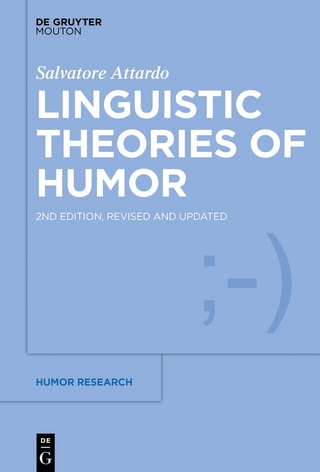
A History of the Chinese Language
Routledge (Verlag)
978-0-367-20985-8 (ISBN)
A History of the Chinese Language provides a comprehensive introduction to the historical development of the Chinese language from its Proto-Sino-Tibetan roots in prehistoric times to Modern Standard Chinese. Taking a highly accessible and balanced approach, it presents a chronological survey of the various stages of the Chinese language, covering key aspects such as phonology, syntax, and semantics.
The second edition presents a revised and updated version that reflects recent scholarship in Chinese historical linguistics and new developments in related disciplines.
Features include:
Coverage of the major historical stages in Chinese language development, such as Old Chinese, Middle Chinese, Early Modern Chinese, and Modern Standard Chinese.
Treatment of core linguistic aspects of the Chinese language, including phonological changes, grammatical development, lexical evolution, vernacular writing, the Chinese writing system, and Chinese dialects.
Inclusion of authentic Chinese texts throughout the book, presented within a rigorous framework of linguistic analysis to help students to build up critical and evaluative skills and acquire valuable cultural knowledge.
Integration of materials from different disciplines, such as archaeology, genetics, history, and sociolinguistics, to highlight the cultural and social background of each period of the language.
Written by a highly experienced instructor, A History of the Chinese Language will be an essential resource for students of Chinese language and linguistics and for anyone interested in the history and culture of China.
Hongyuan Dong is Associate Professor of Chinese Language and Linguistics in the Department of East Asian Languages & Literatures at the George Washington University. He is the author of Semantics of Chinese Questions: An Interface Approach (Routledge 2019).
Table of contents
Preface to the second edition
List of tables
List of figures
List of syntax labels
Chapter 1 Overview
1.1 What is Chinese historical linguistics?
1.2 Terminological clarification
1.3 Periodization of the Chinese language
Chapter 2 Prehistory
2.1 Establishing linguistic genetic relationships
2.2 The Sino-Tibetan languages
2.3 How old is the Sino-Tibetan language family?
2.4 Linguistic properties of Proto-Sino-Tibetan
Chapter 3 Old Chinese: The Elegant Speech
3.1 Evidence of sound change
3.2 Syllable structure of Chinese
3.3 Rhyme groups of Old Chinese
3.4 Initials of Old Chinese
3.5 Consonant clusters
3.6 Methodology of Old Chinese reconstruction
3.7 Tones in Old Chinese
3.8 A reconstructed system of Old Chinese
Chapter 4 Middle Chinese: The Poetic Language
4.1 The rhyme dictionary Qièyùn
4.2 The fǎnqiè method
4.3 Structure of the Guǎngyùn
4.4 Rhyme tables
4.5 The linking method for analyzing the Guǎngyùn
4.6 The comparative reconstruction method
4.7 The notion of děng ("division, grade")
4.8 A reconstructed system of Middle Chinese
Chapter 5 Old Mandarin of Yuan Dynasty Dramas
5.1 The rhyme book Zhōngyuán Yīnyùn
5.2 Categories of initials and finals in Old Mandarin
5.3 Reconstruction of Old Mandarin initials and finals
5.4 Tonal development
Chapter 6 Classical Chinese Grammar
6.1 What is Classical Chinese?
6.2 Morphology
6.3 Word classes
6.4 Basic word order
6.5 Special grammatical constructions
Chapter 7 Vernacular Writing
7.1 Diglossia
7.2 Sources of vernacular writing
7.3 Morphological developments
7.4 Word classes in the vernacular
7.5 Word order in the post-classical era
7.6 Syntactic changes
Chapter 8 Lexical and Semantic Changes
8.1 Extension
8.2 Narrowing
8.3 Shifting of word meaning
8.4 Substitution of lexical items
8.5 Mixed changes
8.6 Euphemism and taboos in lexical changes
8.7 Loanwords and calques
8.8 Clues to meaning change in Chinese characters
Chapter 9 Formation of Modern Standard Chinese
9.1 Origin of the national language
9.2 The modern phonology system
9.3 Morphological properties
9.4 Word classes and cross-category flexibility
9.5 Typical word order
9.6 Aspect markers
9.7 Current uses of special grammatical constructions
9.8 Changes in the modern lexicon
Chapter 10 Modern Chinese Dialects
10.1 Formation of Chinese dialects
10.2 Classification of Chinese dialects
10.3 Mandarin dialects
10.4 The Wu dialects
10.5 The Xiang dialects
10.6 The Gan dialects
10.7 The Kejia dialects
10.8 The Yue dialects
10.9 The Min dialects
10.10 Influences of the national language on dialects
Chapter 11 The Chinese Writing System
11.1 Origin of Chinese characters
11.2 Development of the writing system
11.3 Six types of characters in the liùshū system
11.4 Characters in vernacular writing and dialects
11.5 Simplification of Chinese characters
11.6 Debates about the nature of Chinese writing
References
Appendix I: Major Chronological Divisions of Chinese History
Appendix II: Articulatory Phonetics and IPA
Appendix III: Chinese Pīnyīn Pronunciation Guide
Appendix IV: Correspondence Charts of Pīnyīn and IPA Symbols
Index
| Erscheinungsdatum | 15.01.2021 |
|---|---|
| Zusatzinfo | 48 Tables, black and white; 10 Halftones, black and white; 10 Illustrations, black and white |
| Verlagsort | London |
| Sprache | englisch |
| Maße | 156 x 234 mm |
| Gewicht | 810 g |
| Themenwelt | Schulbuch / Wörterbuch ► Wörterbuch / Fremdsprachen |
| Geisteswissenschaften ► Sprach- / Literaturwissenschaft ► Anglistik / Amerikanistik | |
| Geisteswissenschaften ► Sprach- / Literaturwissenschaft ► Literaturwissenschaft | |
| Geisteswissenschaften ► Sprach- / Literaturwissenschaft ► Sprachwissenschaft | |
| Sozialwissenschaften ► Soziologie ► Spezielle Soziologien | |
| ISBN-10 | 0-367-20985-3 / 0367209853 |
| ISBN-13 | 978-0-367-20985-8 / 9780367209858 |
| Zustand | Neuware |
| Informationen gemäß Produktsicherheitsverordnung (GPSR) | |
| Haben Sie eine Frage zum Produkt? |
aus dem Bereich


